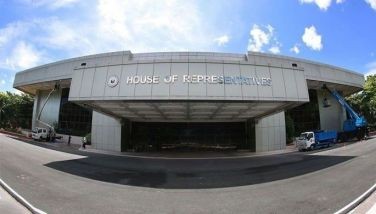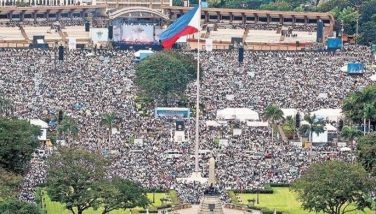Protecting and preserving the ozone layer
September 23, 2001 | 12:00am
In 1985, the existence of an "ozone hole" was discovered over the Antarctic. Furthermore, ozone losses were detected at the Northern hemisphere. These are alarming realities which have caused worldwide apprehension.
The ozone layer "is a thin veil of molecules in the stratosphere" or the upper atmosphere. Ozone is a gas formed by the action of sunlight on oxygen. Ozone molecules absorb ultraviolet (UV) light and prevent harmful UV radiation reaching the earth’s surface. Acting as protective shield, the ozone layer is crucial to the existence of plants and animals as they cannot move around to avoid the UV rays. For human beings, it can cause cancer, cataract and other eye disorders, weakening of the immune system, and other health-related problems.
Scientific studies confirm that ozone depletion is caused by compounds containing chlorine and bromine – such as chloroflourocarbons (CFC) and halons that are released in the atmosphere.
CFCs are a group of compounds made up of chlorine, fluorine, carbon and sometimes hydrogen. They are safe and stable alternatives to refrigerants. They do not react with atmosphere chemicals, thus they last for several years in the atmosphere and finally rise to the UV shielding ozone layer, thereby causing damage on it.
Ozone depletion is a global problem. Several international conferences, world-action research were conducted while several agreements were forged to protect the ozone layer and to phase out ozone depleting substances (ODS).
One of them is the Montreal Protocol of Jan. 1, 1999.
In the Philippines, the DENR acts as the national coordinator for its implementation. The first Philippine country program was conceptualized in 1993. It laid down he details of phasing out ODS, with the Philippine ozone desk (POD) performing the facilitative and coordinative functions.
The DENR-EMB POD reported that completed investment projects founded by the multilateral fund have phased out about 1,300 MT of ODS in various industry sectors. The program also issued regulations to control ODS importation and has conducted extensive information, education and communication programs to support the phaseout of ODS. These efforts were recognized by the UN Environment Programme (UNEP). In 1997, the Philippines was awarded the "Outstanding National Ozone Unit Award" for the implementation of the Montreal Protocol.
Ozone phaseout is undertaken by the DENR through collaborative efforts of Congress and other executive agencies, such as the Department of Trade and Industry, Department of Science and Technology, and Bangko Sentral ng Pilipinas.
The DENR also hopes to tap maximum participation from the public by enjoining them to view its exhibit of ozone friendly products which has been going on since Sept. 17 and ends today, at the lobby of the SSS Livelihood Trade Center, East Ave., Quezon City. This is part of this year’s activities in celebration of the International Month for the Preservation of the Ozone Layer.
The ozone layer "is a thin veil of molecules in the stratosphere" or the upper atmosphere. Ozone is a gas formed by the action of sunlight on oxygen. Ozone molecules absorb ultraviolet (UV) light and prevent harmful UV radiation reaching the earth’s surface. Acting as protective shield, the ozone layer is crucial to the existence of plants and animals as they cannot move around to avoid the UV rays. For human beings, it can cause cancer, cataract and other eye disorders, weakening of the immune system, and other health-related problems.
Scientific studies confirm that ozone depletion is caused by compounds containing chlorine and bromine – such as chloroflourocarbons (CFC) and halons that are released in the atmosphere.
CFCs are a group of compounds made up of chlorine, fluorine, carbon and sometimes hydrogen. They are safe and stable alternatives to refrigerants. They do not react with atmosphere chemicals, thus they last for several years in the atmosphere and finally rise to the UV shielding ozone layer, thereby causing damage on it.
Ozone depletion is a global problem. Several international conferences, world-action research were conducted while several agreements were forged to protect the ozone layer and to phase out ozone depleting substances (ODS).
One of them is the Montreal Protocol of Jan. 1, 1999.
In the Philippines, the DENR acts as the national coordinator for its implementation. The first Philippine country program was conceptualized in 1993. It laid down he details of phasing out ODS, with the Philippine ozone desk (POD) performing the facilitative and coordinative functions.
The DENR-EMB POD reported that completed investment projects founded by the multilateral fund have phased out about 1,300 MT of ODS in various industry sectors. The program also issued regulations to control ODS importation and has conducted extensive information, education and communication programs to support the phaseout of ODS. These efforts were recognized by the UN Environment Programme (UNEP). In 1997, the Philippines was awarded the "Outstanding National Ozone Unit Award" for the implementation of the Montreal Protocol.
Ozone phaseout is undertaken by the DENR through collaborative efforts of Congress and other executive agencies, such as the Department of Trade and Industry, Department of Science and Technology, and Bangko Sentral ng Pilipinas.
The DENR also hopes to tap maximum participation from the public by enjoining them to view its exhibit of ozone friendly products which has been going on since Sept. 17 and ends today, at the lobby of the SSS Livelihood Trade Center, East Ave., Quezon City. This is part of this year’s activities in celebration of the International Month for the Preservation of the Ozone Layer.
BrandSpace Articles
<
>
- Latest
Latest
Latest
May 14, 2024 - 3:43pm
By Ian Laqui | May 14, 2024 - 3:43pm
April 10, 2024 - 5:12pm
By Ian Laqui | April 10, 2024 - 5:12pm
March 4, 2024 - 3:32pm
By Ian Laqui | March 4, 2024 - 3:32pm
March 4, 2024 - 2:12pm
By Kristine Daguno-Bersamina | March 4, 2024 - 2:12pm
February 17, 2024 - 2:31pm
February 17, 2024 - 2:31pm
Recommended




























